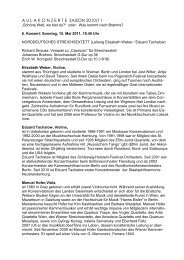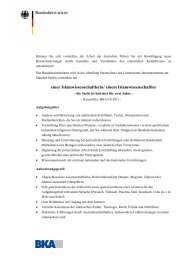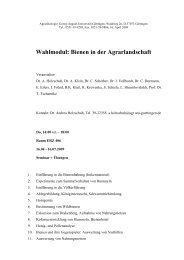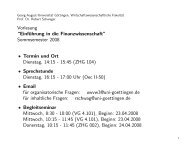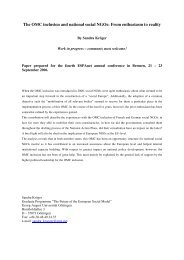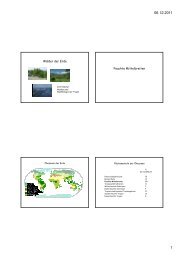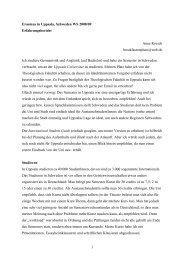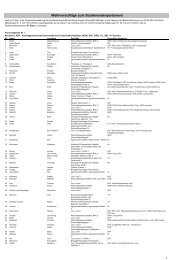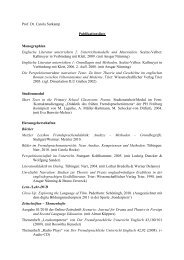Fluid inclusions - Petrography and genetic interpretation of fluid ...
Fluid inclusions - Petrography and genetic interpretation of fluid ...
Fluid inclusions - Petrography and genetic interpretation of fluid ...
Create successful ePaper yourself
Turn your PDF publications into a flip-book with our unique Google optimized e-Paper software.
<strong>Fluid</strong> <strong>inclusions</strong> - <strong>Petrography</strong> <strong>and</strong><strong>genetic</strong> <strong>interpretation</strong> <strong>of</strong> <strong>fluid</strong><strong>inclusions</strong>Dr. Alfons M. van den Kerkh<strong>of</strong>Geowissenschaftliches Zentrum der UniversitätGöttingen (Germany)Course h<strong>and</strong>out:http://www.uni-goettingen.de/de/26174.html1
ProgramDay 19:00-12:00IntroductionClassification <strong>of</strong> <strong>fluid</strong> <strong>inclusions</strong>, mechanisms <strong>of</strong> <strong>fluid</strong> inclusion forming,primary <strong>and</strong> secondary <strong>inclusions</strong>, modification <strong>of</strong> <strong>fluid</strong> <strong>inclusions</strong>14:00-17:00TrainingMicroscopy exercises (COLTAN pegmatites)Day 29:00-12:00Working procedure (sample preparation, equipment), destructive <strong>and</strong> nondestructive<strong>fluid</strong> inclusion analysis, principles <strong>of</strong> microthermometry, isochoredefinition, <strong>fluid</strong> inclusion petrography, application <strong>of</strong> cathodoluminescence14:00-17:00 Water-salt systemsTraining: Microthermometry, Crushing stage, S<strong>of</strong>tware (isochorecalculation), videos.Day 39:00-12:00Water-gas systems, clathrate stability, <strong>fluid</strong>-mineral equilibria <strong>and</strong> graphitestability, COHN equilibria calculations, non-aqueous systems, working withVX diagrams14:00-17:00Training: Microthermometry, S<strong>of</strong>tware (COHN), videos.Day 49:00-12:00 Selectedexamples:<strong>Fluid</strong> <strong>inclusions</strong> in the granitic-pegmatitic system, <strong>Fluid</strong> <strong>inclusions</strong> ingranulites, <strong>Fluid</strong> <strong>inclusions</strong> in ore deposits14:00-17:00Free exercises, presentations <strong>of</strong> participants <strong>and</strong> discussion.2
<strong>Fluid</strong> inclusion study short working planI. Sample preparationDoubly polished sectionsII. Documentation1. Microscopy <strong>and</strong> <strong>fluid</strong> inclusion selection2. Drawings <strong>and</strong> photos3. Classification <strong>of</strong> <strong>fluid</strong> <strong>inclusions</strong>a. Description (one-phase, 2-phase, multiphase,daughter crystals etc.)b. Relative phase volumes (fill degree)c. Inclusion size, morphologyd. Relative age (primary, pseudosecondary,secondary)III. Microthermometry1. Cooling experi3ment (until ca. -180°C)observation <strong>of</strong> phase nucleations (Tn V, CO 2S, etc. )2. Warming experiment (-180 until about 35°C)detection <strong>of</strong> phase transition temperatures(Te, Tm CO 2, Tm ice, Th CO 2, Tm ice, Tm hydrate)3. Heating experiment (aqueous <strong>inclusions</strong>)Th total, Tm saltIV. Data treatmentCalculation <strong>of</strong> compositions <strong>and</strong> densities, isochore calculation3
Working procedure <strong>of</strong> a <strong>fluid</strong> inclusion study(revised after Van den Kerkh<strong>of</strong>, 1988)4
Optical properties <strong>of</strong> solid phases in <strong>fluid</strong> <strong>inclusions</strong> in order <strong>of</strong>increasing refractive indexname composition refract. birefringence crystal habit commentsindexsystemliquid carbon dioxide CO 2(liq.) 1.195carbon dioxide CO 2(s.) ? M? translucent, microcrystallineT
Estimation <strong>of</strong> volume fractions 16
Estimation <strong>of</strong> volume fractions 27
<strong>Fluid</strong> inclusion classificationClassification scheme for <strong>fluid</strong> <strong>and</strong> melt <strong>inclusions</strong> in minerals based upon phasesobserved at room temperature L=liquid, V= vapour, S=solid, GL=glass (from:Sheperd, 1985)Examples <strong>of</strong> phases in <strong>fluid</strong><strong>inclusions</strong> in porphyry copperdeposits (from: Nash JT, 1976, USGeol. Survey Pr<strong>of</strong>. Papers 907D)8
Eutectic properties <strong>of</strong> salt solutions(Hein, Compact course, 1990)9
Microthermometry abbreviations„ A consensus <strong>of</strong> <strong>fluid</strong> inclusion workers on usage <strong>of</strong> microthermometric terms wasreached <strong>and</strong> first printed in Vol. 10 <strong>of</strong> COFFI. It is suggested that if this terminology isused consistently in the future papers, considerable ambiguity will be avoided (For ease <strong>of</strong>typewriting <strong>and</strong> typesetting, I suggest not using subscripts) „ (Roedder 1981, <strong>Fluid</strong>Inclusion Research – Proceedings <strong>of</strong> COFFI)10
Relative age <strong>of</strong> <strong>fluid</strong> <strong>inclusions</strong>Primary-secondary“classificationPrinciple sketch <strong>of</strong> inclusion classification,based on Roedder´s (1981) criteria. Thestippled line denotes growth zoning. P=primary, PS= pseudosecondary <strong>and</strong> S=secondary <strong>inclusions</strong>. The P <strong>and</strong> PS<strong>inclusions</strong> in the inner growth zone are olderthan the P <strong>and</strong> PS ones in the outer zone.Inclusions along the growth planes aredenoted as primary. The S trail, extending tothe surface <strong>of</strong> the crystal, postdates all P <strong>and</strong>PS <strong>inclusions</strong>(from: Hansteen, 1988, C<strong>and</strong>. Scient. Thesis,Univ. Oslo)11
Primary <strong>fluid</strong> <strong>inclusions</strong> (diagnostic criteria)(a) Diagnostic criteria for classifying <strong>fluid</strong> <strong>inclusions</strong> as primary (after Roedder, 1979)(b) Different occurrences <strong>of</strong> primary <strong>fluid</strong> <strong>inclusions</strong> in relation to growth zoning (compilation)(from: Van den Kerkh<strong>of</strong> & Hein, 2001, Lithos 55, 27-47)12
Trail terminology / Homogeneous –heterogeneous trappingTrail terminology (Vollbrecht,1989) composed after Simmons<strong>and</strong> Richter (1976) <strong>and</strong> Kranz(1983). A main distinction ismade between transgranular,intergranular, <strong>and</strong> intragranular<strong>inclusions</strong> (b) The intragranular<strong>fluid</strong> <strong>inclusions</strong> may decoratedifferent internal grain textures<strong>and</strong> are accordingly subdivided.(below) (a) Homogeneoustrapping <strong>of</strong> <strong>fluid</strong>s. At roomtemperature (after cooling) phaseseparation may result fromshrinkage, saturation or unmixing<strong>of</strong> the original homogeneous<strong>fluid</strong>. (b) Heterogeneous trapping<strong>of</strong> <strong>fluid</strong>s. <strong>Fluid</strong> <strong>inclusions</strong> <strong>of</strong>variable composition <strong>and</strong> phaseratio are trapped at the sametime (Van den Kerkh<strong>of</strong> & Hein,2001, Lithos 55, 27-47)13
<strong>Fluid</strong> inclusion modification(Hansteen, 1988) (Bodnar, Binns & Hall, 1989, J.Metam. Geol. 7, 229-24214
Overview <strong>of</strong> methods for analyzing <strong>fluid</strong><strong>inclusions</strong>NON-DESTRUCTIVE ANALYSIS1. OPTICAL MICROSCOPY ANDVIZALIZING TECHNIQUESPetrographical microscopeCL-Microscopy /SEM-CLUV-MicroscopeIR-MicroscopeTEM<strong>fluid</strong> inclusion abundance, chronologytextural relations with host mineral, secondaryquartzdetection <strong>of</strong> hydrocarbonsvisualisation <strong>of</strong> <strong>fluid</strong> <strong>inclusions</strong> in semi-opaque<strong>and</strong> opaque minerals (e.g. cassiterite, chromite,sphalerite, pyrite)dislocations /micro-cracks around FI2. MICROTHERMOMETRY composition <strong>and</strong> molar volume3. VIBRATIONAL SPECTROSCOPYLaser excited micro-Raman spectroscopy composition <strong>of</strong> non-aqueous <strong>fluid</strong>s,identification <strong>of</strong> daughter crystalsFT-IR detection <strong>of</strong> CO 2 , H 2 O, hydroxyl, ...Fluorescence spectroscopy4. PARTICLE BEAMS TECHNIQUESElectron microprobe (EPMA)Proton probes: PIXE, PIGE, SXRFElectron synchrotronDESTRUCTIVE ANALYSISB u l k a n a l y s i s1. MECHANICALCrushing stage2. STEPWISE HEATINGAcoustic emission (AE) 'Decrepitometry'Gas chromatographyMass spectrometry3. CRUSH AND LEACH combined withmicro-chemical analysis, AAS, etc.S i n g l e i n c l u s i o n sdetection <strong>of</strong> hydrocarbons<strong>inclusions</strong> near the sample surfacenon-aqueous <strong>fluid</strong>s, qualitativefinger print <strong>of</strong> <strong>fluid</strong> inclusion contentbulk <strong>fluid</strong> compositionbulk <strong>fluid</strong> composition, isotopescomposition <strong>of</strong> aqueous <strong>fluid</strong>s, element ratios,dissolved daughter crystals1. EPMA or SIMS (opened <strong>inclusions</strong>) identification daughter minerals, composition<strong>of</strong> FI (freezing method)2. LA-ICPMS composition including trace elements15
Analytical equipmentCrushing stageHeating/freezing stage(below) Cross-section <strong>of</strong> theLinkam stage (Sheperd, 1981) Pt=platinum resistance temperaturesensor(right) Cross section (top) <strong>and</strong> plan view <strong>of</strong> the USGSstage from Werre et al. (1979). Arrows indicate the gasflow paths. P, portals for gas flow, A-A, plane <strong>of</strong> sectionaboveLaser Raman Microspectromer (LRM)Scheme <strong>of</strong> the light pathin a Laser RamanMicrospectrometer(Microdil-28). INT.R.=interrupter, O.S. =optical scanner, P.M.photomultiplier, G1-3 =holographic gratings,S1-3= opening slits16
Phase transitions during microthermometry runsPhase transitions in aqueous <strong>inclusions</strong>Phase transitions in gaseous <strong>inclusions</strong>17
1-Component systems18
The system H 2 OSchematic, polybaric, V-Tprojection<strong>of</strong> the onecomponentH2O solid-liquidvaporequilibria including 3solid-solid-liquid P, T invariantpoints for high pressure icepolymorphs. Contructed fromdata summarized byEisenberg & Kauzmann(1969)19
H 2 O isochoresH 2 O isochores modified from Fischer (1976). Enlargement <strong>of</strong> the low pressure region, in the box, appears to the right.20
Density estimates (CO 2 <strong>and</strong> CH 4 )(a) Densities <strong>of</strong>liquid <strong>and</strong> gas onthe boiling pointcurve as afunction <strong>of</strong>temperature (b)Molar volume <strong>of</strong>the liquid on theboiling point curve(from: Van denKerkh<strong>of</strong> & Thiéry,2001, Lithos 55,49-68)Saturation curve <strong>of</strong>methane (afterZagoruchenko &Zhuravlev 1970)21
CO 2 isochoresPhase diagram for CO 2 showing densities (g/cc) <strong>of</strong> several isochores. Data fromcompilation <strong>of</strong> Angus et al. (1973). CP = critical point at 31°C.Combined isochores for CO 2 <strong>and</strong> H 2 O. At higher PT (>1.5 kbar; >500°C) CO 2has higher density than for water, which is trapped at the same conditions22
Binary water-salt systemsThe system H 2O-NaClNaCl-H 2 O system, temperature-composition diagram at 1 bar. All phases coexist withvapor. data from Potter et al. (1978) <strong>and</strong> Linke (1965).The system H 2O-CaCl 223
The system H 2 O-NaCl (PT)24
The system H 2 O-NaCl (XT)25
H 2 O-NaCl isochores (1)26
H 2 O-NaCl isochores (2)Iso-Th lines for NaCl-H 2 O <strong>inclusions</strong> having salinities <strong>of</strong> 0, 5, 10, 15, 20 <strong>and</strong> 25wt%% NaCl calculated using data from Bodnar <strong>and</strong> Vityk27
The system H 2 O-CO 2 : phase transitions <strong>and</strong>immiscibility28
The system H 2 O-CO 2 (PT)29
The system H 2 O-CO 2 (VX)30
Calculation <strong>of</strong> composition <strong>and</strong> molar volume31
Ternary water salt systemsH 2 O-NaCl-KCl(Sterner, Hall &Bodnar, 1988, GCA52, 989-1005)H 2 O-NaCl-CaCl 2(Konnerup-Madsen, 1979)32
Binary gas systems (topology)33
Binary gas systems: CO 2 -CH 4 (PT)Phase transitions in the system CO 2 -CH 4 at varying temperature <strong>and</strong>pressure34
The system CO 2 -CH 4 (VX) (1)35
The system CO 2 -CH 4 (VX) (2)36
The system CO 2 -N 2 (VX)37
Gas systems (phase transitions atconstant volume)(Van den Kerkh<strong>of</strong> & Thiéry, 2001, Lithos 55, 49-68)38
The application <strong>of</strong> VX-diagrams39
The ternary system CO 2 -CH 4 -N 2(Van den Kerkh<strong>of</strong> & Thiéry, 2001,Lithos 55, 49-68)40
Literature selectionTextbooks:ANDERSEN T, FREZZOTTI ML, BURKE EAJ eds. (2001) <strong>Fluid</strong> <strong>inclusions</strong>: phaserelationships - methods- applications (special issue). Lithos 55 (1-4), 320 pp.SHMULOVICH KI, YARDLEY B, GONCHAR GG (1995) <strong>Fluid</strong>s in the crust. Equilibrium <strong>and</strong>transport properties. Chapman & Hall, 323 pp.De VIVO B, FREZZOTTI ML (1994) <strong>Fluid</strong> <strong>inclusions</strong> in minerals: methods <strong>and</strong> applications.Short course <strong>of</strong> the working group (IMA) "Inclusions in Minerals" (Siena) <strong>Fluid</strong>s ResearchLaboratory, Department <strong>of</strong> Geological Sciences, YPI, BlacksburgGOLDSTEIN RH, REYNOLDS TJ (1994) Systematics <strong>of</strong> tluid <strong>inclusions</strong> in dia<strong>genetic</strong>minerals. SEPM Short Course 31. Society for Sedimentary Geology. SEPM, Tulsa,OklahomaPARNELL J ed. (1994) Ge<strong>of</strong>luids: Origin, Migration <strong>and</strong> Evolution <strong>of</strong> <strong>Fluid</strong>s in SedimentaryBasins. Geol. Soc. Spec. Publ. 78, 372 pp.WALTHER JV, WOOD BJ eds. (1986) <strong>Fluid</strong>-rock interactions during metamorphism.Advances in physical chemistry 5, Springer-New YorkLEEDER O, THOMAS R, KLEMM W (1987) Einschlüsse in Mineralien. VEB DeutscherVerlag für Grundst<strong>of</strong>fenindustrie, Leipzig., 180 pp.SHEPHERD TJ, RANKIN AH, ALDERTON DHM (1985) A practical guide to <strong>fluid</strong> <strong>inclusions</strong>tudies 239 pp. Blackie- Glasgow.ROEDDER E (1984) <strong>Fluid</strong> <strong>inclusions</strong>. Reviews in Mineralogy, Vol. 12, 644 pp. MineralogicalSociety <strong>of</strong> America, Washington.HOLLISTER LS, CRAWFORD ML eds. (1981) Short course in <strong>fluid</strong> <strong>inclusions</strong>: application topetrology. 304 p. (Calgary, Mineralogical Association <strong>of</strong> Canada)SAMSON I, ANDERSON A, MARSHALL D eds. (2003) <strong>Fluid</strong> <strong>inclusions</strong> - Analysis <strong>and</strong>Interpretation. Short Course Series Vol. 32, Mineralogical Association <strong>of</strong> Canada. 374 pp.SORBY HC (1858) On the microscopic structure <strong>of</strong> crystals, indicating the origin <strong>of</strong> minerals<strong>and</strong> rocks. Geol. Soc. London Quart. J., 14, pt. I, 453-500.Regular issues:FLUID INCLUSION RESEARCH - Proceedings <strong>of</strong> COFFI (1968-1998) Roedder E &Kozlowski A (eds.) Ann Arbor. The University <strong>of</strong> Michigan Press.ECROFI Abstracts (biannual from 1970). Abstract volumes. Selections <strong>of</strong> contributionspublished in special issues <strong>of</strong> Eur. J. Mineral.PACROFI Abstracts (biannual from 1984). Abstract volumes (some published in specialissues <strong>of</strong> Geochim. Cosmochim. Acta).Literature selection "ge<strong>of</strong>luids":BODNAR RJ (1983) A method <strong>of</strong> calculating <strong>fluid</strong>-inclusion volumes based on vapor bubblediameters <strong>and</strong> P-V-T-X properties <strong>of</strong> inclusion <strong>fluid</strong>s. Econ. Geol. 76, 535-542.DUBESSY J, POTY B., RAMBOZ C (1989) Advances in C-O-H-N-S <strong>fluid</strong> geochemistrybased on micro-Raman spectrometric analysis <strong>of</strong> <strong>fluid</strong> <strong>inclusions</strong>. Eur. J. Mineral. 1, 51 7-534.HALL DL, BODNAR RJ (1990) Methane in <strong>fluid</strong> <strong>inclusions</strong> from granulites: A product <strong>of</strong>hydrogen diffusion? Geochim. Cosmochim. Acta 54, 641-651.HUIZENGA JM (1995) <strong>Fluid</strong> evolution in shear zones from the late Archean Harare-Shamva-Bindura Greenstone Belt (NE Zimbabwe). Thermodynamic calculations <strong>of</strong> the C-O-H systemapplied to <strong>fluid</strong> <strong>inclusions</strong>. Ph.D. Dissertation. Free University -Amsterdam.41
KONNERUP-MADSEN J (1979) <strong>Fluid</strong> <strong>inclusions</strong> in quartz from deep-seated graniticintrusions. Lithos 12, 13-23.KREULEN R (1987) Thermodynamic calculations <strong>of</strong> the C-O-H system applied to <strong>fluid</strong><strong>inclusions</strong>: are <strong>fluid</strong> <strong>inclusions</strong> unbiased samples <strong>of</strong> ancient <strong>fluid</strong>s ? Chem. Geol. 61, 59-64.LAMB WM, VALLEY JW, BROWN PE (1987) Post-metamorphic CO 2 -rich <strong>fluid</strong> <strong>inclusions</strong> ingranulites. Contr. Mineral. Petrol. 96, 485-495.NEWTON RC (1989) Metamorphic <strong>fluid</strong>s in the deep crust, Ann. Rev. Earth Planet. Sci. 17,385-412.ROEDDER E (1979) <strong>Fluid</strong> <strong>inclusions</strong> as samples <strong>of</strong> ore <strong>fluid</strong>s. In: HL Barnes (ed.)Geochemistry <strong>of</strong> hydrothermal ore deposits. 2nd ed. 684-737. Wiley- New YorkROEDDER E (1990) <strong>Fluid</strong> inclusion analysis – Prologue <strong>and</strong> epilogue. Geochim.Cosmochim. Acta 54, 495-507.SWANENBERG HEC (1980) Phase equilibria in carbonic systems <strong>and</strong> their application t<strong>of</strong>reezing studies <strong>of</strong> <strong>fluid</strong> <strong>inclusions</strong>. Contr. Mineral. Petrol. 88, 3303-3306.TOURET JLR (1977) The significance <strong>of</strong> <strong>fluid</strong> <strong>inclusions</strong> in metamorphic rocks. In: Fraser(ed.), Thermodynamics in Geology, 203-22T, D. Reidel - Dordrecht.TOURET JLR (1987) <strong>Fluid</strong> <strong>inclusions</strong> <strong>and</strong> pressure-temperature estimates in deep-seatedrocks. In: Helgeson (ed.) Chemical transport in metasomatic processes. NATO ASI SeriesC: Mathematical <strong>and</strong> Physical Sciences. Vol. 218, 91-121.TOURET JLR (1992) CO 2 transfer between the upper mantle <strong>and</strong> the atmosphere: temporarystorage in the lower continental crust Terra Nova 4, 87-98.VAN DEN KERKHOF AM, HEIN UF (2001) <strong>Fluid</strong> inclusion petrography. In: ANDERSEN T,FREZZOTTI ML, BURKE EAJ ed. <strong>Fluid</strong> <strong>inclusions</strong>: phase relationships - methodsapplications(special issue). Lithos 55 (1-4), 320 pp.VITYK MO, BODNAR RJ (1995) Do <strong>fluid</strong> <strong>inclusions</strong> in high grade metamorphic terranespreserve peak metamorphic density during retrograde decompression? AmericanMineralogist.<strong>Fluid</strong> systems:BISCHOFF JL, PITZER KS (1989) Liquid vapor relations for the system NaCI-H 2 O; summary<strong>of</strong> the P-T- X surface from 300 to 500'C. Am. J. Sci. 289, 217-248.BODNAR RJ, BURNHAM CW, STERNER SM (1985) Synthetic <strong>fluid</strong> <strong>inclusions</strong> in naturalquarlz. - III. Determination <strong>of</strong> phase equilibrium properties in the system H 2 O-NaCl to1000°C <strong>and</strong> 1500 bars. Geochim. Cosmochim. Acta 49, 1861-1873.BURRUSS RC (1981) Analysis <strong>of</strong> <strong>fluid</strong> <strong>inclusions</strong>: Phase equilibria at constant volume.Amer. J. Sci. 281, 1104-1126.CHOU I.-M., STERNER SM, PITZER KS (1992) Phase relations in the system NaCI-KCI-H2O. IV. Differential thermal analysis <strong>of</strong> the sylvite liquidus in the KCI-H 2 O binary, theliquidus in the NaCI-KCI-H 2 O ternary, <strong>and</strong> the solidus in the NaCI-KCI binary to 2 kbpressure, <strong>and</strong> a summary <strong>of</strong> experimental data for the thermodynamic PTX analysis <strong>of</strong>solid-liquid equilibria at elevated PT conditions. Geochim. Cosmochim. Acta 56, 2281-2293.DIAMOND LW (1994) Salinity <strong>of</strong> multivolatile <strong>fluid</strong> <strong>inclusions</strong> determined from clathratehydrate stability. Geochim. Cosmochim. Acta 58, 19-41.FISHER JR (1976) The volumetric properties <strong>of</strong> H 2 O - a graphical portrayal. Joum. ResearchU.S. Geol. Survey 4 (2), 189-193.HALL DL, STERNER SM, BODNAR RJ (1988) Freezing point depression <strong>of</strong> NaCI-KCI-H 2 Osolutions. Econ. Geol. 83, 197-202.HANOR JS (1980) Dissolved methane in sedimentary brines: potential effect on the PVTproperties <strong>of</strong> <strong>fluid</strong> <strong>inclusions</strong>. Econ. Geol. 75, 603-617.42
JOYCE DB, HOLLOWAV JR (1993) An experimental determination <strong>of</strong> the thermodynamicproperties <strong>of</strong> H 2 O-CO 2 -NaCl <strong>fluid</strong>s at high pressures <strong>and</strong> temperatures. Geochim.Cosmochim. Acta 57, 733-746.ROSSO KM, BODNAR RJ (1994) Detection limits <strong>of</strong> CO 2 in <strong>fluid</strong> <strong>inclusions</strong> usingmcrothermometry <strong>and</strong> Laser Raman Spectroscopy <strong>and</strong> the spectroscopic characterization<strong>of</strong> CO2. Geochim. Cosmochim. Acta.SEITZ JC, PASTERIS JD (1990) Theoretical <strong>and</strong> practical aspects <strong>of</strong> differential partitioning<strong>of</strong> gases by clathrate hydrates in <strong>fluid</strong> <strong>inclusions</strong>. Geochim. Cosmochim. Acta 54, 631-639.STERNER SM, HALL DL, BODNAR RJ (1988) Synthetic <strong>fluid</strong> <strong>inclusions</strong>. V. Solubilityrelations in the systern NaCI-KCI-H 2 O under vapor-saturated conditions. Geochim.Cosmochim. Acta 52, 989-1 005.STERNER SM, CHOU I-M, DOWNS RT, PITZZER KS (1992) Phase relations in the systemNaCI-KCI-H 2 O. V. Thermodynamic -PTX analysis <strong>of</strong> solid-liquid equilibria at hightemperatures <strong>and</strong> pressures. Geochim. Cosmochim. Acta 56, 2295-2309.TAKENQUCHI S, KENNEDY GC (1965) The solubility <strong>of</strong> carbon dioxide in NaCI solutions athigh temperatures <strong>and</strong> pressures. Amer. J. Sci. 263, 445-454.THIÉRY R, VAN DEN KERKHOF AM, DUSESSV J (1994) vX properties <strong>of</strong> CH 4 -CO 2 <strong>and</strong>CO 2 -N 2 <strong>fluid</strong> <strong>inclusions</strong>: modelling for T
HOLLOWAY JR (1977) Fugacity <strong>and</strong> activity <strong>of</strong> molecular species in supercritical <strong>fluid</strong>s. In: DGFrazer (ed.) Thermodynamics in Geology, D. Reidel - Dordrecht, 161-181.MACDONALD AJ, SPOONER ETC (1981) Calibrations <strong>of</strong> a LINKAM TH600 programmableheating-cooling stage for microthermometric examination <strong>of</strong> <strong>fluid</strong> <strong>inclusions</strong>. Econ. Geol. 76,1248-1258.SHEPHERD TJ (1981) Temperature-programmable heating-freezing stage for microthermometricanalysis <strong>of</strong> <strong>fluid</strong> <strong>inclusions</strong>. Econ. Geol. 76, 1244-1 247.ZHANG YG, FRANTZ JD (1987) Determination <strong>of</strong> homogenization temperatures <strong>and</strong> densities<strong>of</strong> supercritical <strong>fluid</strong>s in the system NaCI-KCI-CaCI2-H 2 O using synthetic <strong>fluid</strong> <strong>inclusions</strong>.Chem. Geol. 64, 335-350.<strong>Fluid</strong> inclusion experiments :BAKKER RJ, JANSEN JB (1990) Preferential water leakage from <strong>fluid</strong> <strong>inclusions</strong> by means <strong>of</strong>mobile dislocations. Nature 345, No.6270, 58-60.BODNAR RJ, STERNER SM (1985) Synthetic <strong>fluid</strong> <strong>inclusions</strong> in natural quartz. – II. Applicationto PVT studies. Geochim. Cosmochim. Acta 49, 1855-1859.BODNAR RJ, BINNS PR, HALL DL (1989) Synthetic <strong>fluid</strong> <strong>inclusions</strong>. -VI. Quantitative evaluatian<strong>of</strong> the decrepitation behavior <strong>of</strong> <strong>fluid</strong> <strong>inclusions</strong> in quartz at one atmosphere confiningpressure. J. metamorphic Geol. 7 (2), 229-242.CORDIER P, DOUKHAN JC, RAMBOZ C (1994) Influence <strong>of</strong> dislocations on water leakage from<strong>fluid</strong> <strong>inclusions</strong> in quartz: a quantitative reappraisal. Eur. J. Mineral. 6, 746-752.STERNER SM, BODNAR RJ (1989) Synthetic <strong>fluid</strong> <strong>inclusions</strong> - Vll. Re-equilibration <strong>of</strong> <strong>fluid</strong><strong>inclusions</strong> in quartz during laboratory-simulated metamorphic burial <strong>and</strong> uplift. J. metam.Geol. 7 (2), 243-260.WATSON EB, BRENAN JM (1987) <strong>Fluid</strong>s in the lithosphere, 1. Experimentally-determinedwetting characteristics <strong>of</strong> CO 2 -H 2 O <strong>fluid</strong>s <strong>and</strong> their implications for <strong>fluid</strong> transport, host-rockphysical properties, <strong>and</strong> <strong>fluid</strong> inclusion formation. Earth Planet. Sci Letters 85, 497-515.44



